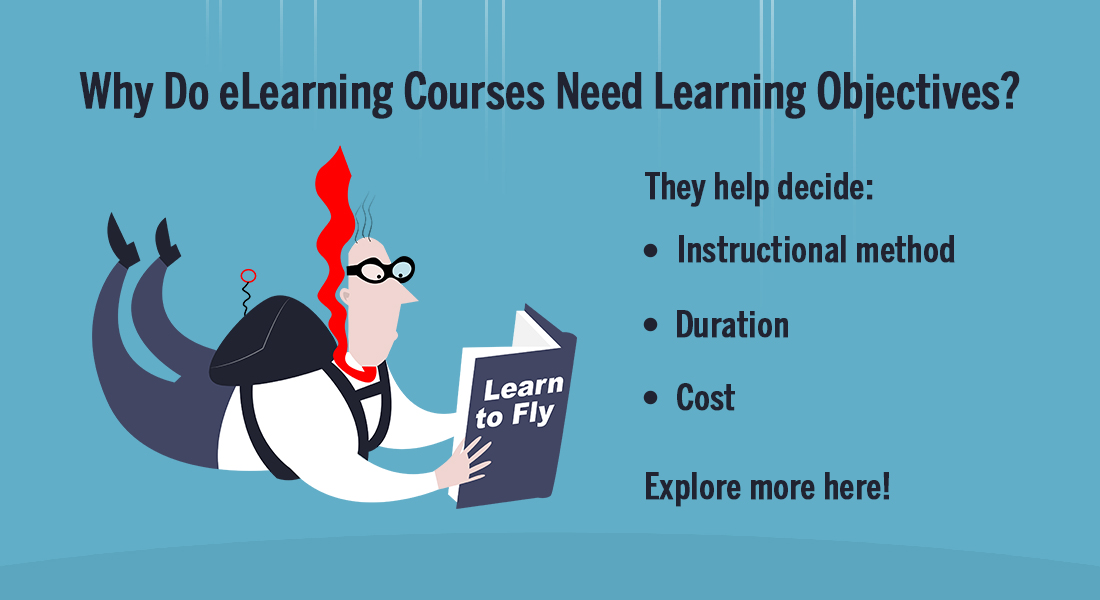Learning Objectives Set the Stage for E-learning Courses: Why?

X is the training manager for ABC Inc. He was assigned the task of getting an e-learning course developed for field sales executives. All that X got as a brief from the Director – Sales was this:
“I want to train my sales executives on the new product we are going to launch. We don’t have time to get them all here for classroom training, so online training seems a good option. Here is a bunch of product manuals and guides the product team has come up with. Oh, I think I also have some PPTs that the product team used when making presentations to me. I can send them over to you. Use these and get the elearning course developed.“
→ Download Now: Instructional Design 101
Can you get the course developed with this piece of information and the bunch of resources the Director talked about? Obviously not. If you were in X’s shoes what would be going on in your mind? You would have several unanswered questions in your mind. For example:
- What is the main purpose of the course – is it to educate sales people about how the product works or is it about how to sell the product? What should be the focus of the course?
- How long should the course be? Should it be made into a series of short bite-sized modules or should it be one single course to be taken at a stretch?
- What is the budget available for the course? What are the interactive elements I can use in the course?
- How will sales people access the courses? Will they take them when at office or should the courses be available on mobile devices so that they can access them while on the field?
- Should sales people be tested at the end of the course? Will they get certificates on successful completion?
X went back to the Director – Sales and said, “I can do the elearning course for you but I need answers to these questions”. These questions prompted the Director – Sales to define what exactly he wanted his field sales representatives to be able to do after completing the course. Essentially, what the Director-Sales wanted was his salespeople to quickly:
- Understand the features of the new product and be able to differentiate its benefits vis-à-vis others in the product line
- List down the customer problems the new product is able to solve
- Know how to access product information and resources hosted on the LMS when faced with customer queries or objections
In short, what the Director – Sales did was to define the learning objectives for the elearning course.
What are learning objectives?
A learning objective is a precise and explicit statement that describes, in measurable terms, what the learner will be able to do after taking up a course.
How are they important in elearning?
They are important for elearning courses because they help define the:
- Scope of the course
- Instructional Strategy
- Evaluation methodology
- Duration of the course
- Cost of the course
Scope of the content:
Learning objectives help define the scope of the content. When the Director – Sales shares a bunch of information for the course, the scope helps identity which content will help attain the learning objectives and what can be skipped. Even from the content that has been chosen, we can distinguish the absolute essential from the rest which may be ‘good to know’ but can be done at the discretion of the learner.
If we refer to the product training example shared earlier, sales representatives didn’t have to have thorough technical knowledge about the product. However, what was important is that they need to know fundamental information such as the problems the product helps solve, the key features of the product, and in the case of customer queries, how to access relevant information from the company’s LMS. The learning objectives will be defined keeping these requirements in mind.
Instructional Strategy:
Secondly, learning objectives help decide the instructional strategy of the course. If we want our sales people to merely identify the different features or parts of a product, you may not require a specific instructional strategy as it involves stating of facts. However, you may have to present the facts in a format that makes it easy for the sales people to remember. If we need the sales people to align product features with the needs of the customers or explain to them how it brings value to customers, the strategy adopted will have to be different. In such cases, scenario-based learning or a story-based learning strategy might be a better option. Therefore, once we define the learning objectives, it helps chalk out the right instructional strategy.

Instructional Design 101
A Handy Reference Guide for eLearning Designers
- eLearning standards
- Streamlined instructional design process
- Effective assessments
- And More!
Evaluation:
Next, learning objectives are crucial when creating summative assessments or quiz questions at the end of the course. They provide the parameters or subject matter on which the learners should be tested. For example, if the learning objective of the course is to enable the sales person ‘successfully overcome customer objections or be able to confidently answer customer queries’, and the final quiz questions are talking about product features, it does not add up. The learning outcome of the course cannot be effectively evaluated. Thus, learning objectives help in evaluating the learning outcome of the course.
Duration and Cost:
Very often, the budget for the course is defined. Within the given budget we will have to figure out the ideal instructional strategy and the duration of the course. If the course has limited budget, we may not be able to include complicated simulations, interactivities, or graphics. However, when we have defined learning objectives, it ensures that courses stay on track without their purpose getting diluted due to indiscriminate cutting of features or interactivities. Basically, learning objectives influence the instructional strategy which in turn defines the cost and duration of the course. It also guides us in making sure our money is well-spent.
To conclude, if we clearly define the learning objectives, we will be able to evaluate and assess the direction in which the course is going. Right from the content that is chosen as a part of the course, the media elements, instructional strategy, to the duration and cost factors are directly or indirectly influenced by the learning objectives. They truly set the stage for elearning courses. Therefore, it pays to first define the learning objectives succinctly before developing an elearning course.



![Understanding the Importance of Learning Objectives in eLearning [SlideShare]](https://blog.commlabindia.com/hubfs/Imported_Blog_Media/learning-objectives-importance-eLearning-slideshare.jpg)

